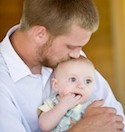All parents want to understand their baby, and I believe most parents encounter times when this can be an overwhelming task, especially in the first 3 to 4 months. Your head may be screaming WHAT? WHAT DO YOU NEED? As again you repeat the cycle of feeding, releasing a few burps, and trying to settle them to sleep. I know this scenario only to well as I too had times like this in my early career.
Twenty-three years ago I started as a Maternity Nurse in the United Kingdom. I worked 24 hours a day, six days a week, living in with families whom had given birth to twins and believe me, there were times I definitely struggled to understand what the baby’s needed. It often didn’t make sense either – they’d sometimes been up for hours yet still they wouldn’t sleep. Surely they were absolutely exhausted!
It was during these often heart breaking episodes that I felt I was missing a piece of the newborn puzzle. That there was something I hadn’t been taught that could help them. Thankfully, over the next two years the many baby’s I cared for revealed that remarkable puzzle piece and oh, what a discovery it was and has been!
In the first eight weeks, before newborns respond more knowingly to their environment, the majority of their communication and body movements relate to their digestive functions. During this time all newborns express what I have coined as the Six-Wind-Cues.
When you learn to read and respond consciously to these Wind-Cues, an exquisite exchange of knowing begins to form as your baby intuitively comprehends that you understand them. This responsive care then cultivates the healthy ‘rest and digest’ way of being for bubs, while enhancing mental and physical health for your entire family.
Traditionally, the ingested air a newborn swallows is thought to be bothersome, which of course can be true. However, like everything in life, where there is a negative there is also a positive. Mother Nature’s gift of newborns ingesting air is no exception to this universal principal.
Not only does the intake of air play a substantial role in digestion, it also makes an immense contribution to our early physical, mental and emotional capabilities from the first seconds of life, until at least four months of age. The natural mechanism of air in a baby’s body is truly a very powerful instrument of nature.
Wind’s 5 physiological developments and the Six-wind-Cues
From the moment of birth, ingested air is the initiator and/or helps to progress these five physiological developments:
- vision
- smiles
- mastication
- first ever controlled arm movements*
- first gooing and gaaing.*
The first 2 of the Six-Wind-Cues are marked with an asterisk above. The 4 remaining Wind-Cues, associated with the first 3 physiological developments above, are:
- windy stare
- rolling/fluttering eyes
- windy smile
- chewing motion with tongue poking out
These Six-Wind-Cues occur when air sits in the upper regions of the stomach, or throat of a newborn. When observed it means that the trapped air that produced the Wind-Cue, or cues, is ready to be released. When the burp is expelled, through using Nature’s Wind Sequence [1] the Wind-Cue disappears, only to return when air once again moves to the upper regions. When a baby is left to communicate any of these Six-Wind-Cues for too long without burping, they will eventually become unsettled.
This happens because the retained burp in the upper regions stops the release of other wind that sits in the stomach. The accumulated, retained air is then left to move through the intestines, potentially causing behaviours like bopping on and off the breast while feeding, arching backwards, pedalling legs, squirming, sporadic sleep, crying and screaming, which may contribute to some babies being diagnosed with colic and reflux, or what I call Digestive Overload.
Whenever any of the Six-Wind-Cues are present a baby becomes very relaxed in their body and communication. On occasion however, there will be times when they are calm and show they are ready to burp, only to start grizzling and crying while pedalling their legs. This occurs because baby simultaneously experiences discomfort in their intestines or bowel.
When this happens they need us to alleviate this uncomfortable feeling first by placing them in certain relieving positions. Once their calmness is reinstated we can then continue with releasing their burps. By consistently using the relaxed moments that the Six-Wind-Cues produce to release trapped air, we teach babies to expel their wind in a more placid manner with only short bursts of unsettled behaviour.
Often the Six-Wind-Cues happen simultaneously and this cycle of intimate communication is continually happening throughout the day. This early mechanism of ingested air is innate to humans.
Windy stare
The windy stare is present from birth and can be described as a far off gaze to nowhere. Clearly this Wind-Cue helps stimulate the early relationship with light, leading a baby to absorb the finer details of their environment and body. Around eight to twelve weeks, the windy stare becomes less recognisable. It becomes more of a ‘day dreaming look’ with blinking, as your baby’s vision becomes more environmentally stimulated than created by wind.
Traditionally this Wind-Cue, like some of the others, has not been recognised as significant. It is often the time when parents do other things because their baby is calm. But, as mentioned earlier if baby is left too long with this Wind-Cue, the trapped burp will eventually cause heightened communication, which is often misdiagnosed as hunger or tiredness.
The windy stare can have parents wondering why their baby will not close their eyes and go to sleep when they have been awake for a while. The release of wind is needed for their eyes to close.
Rolling, fluttering eyes
This Wind-Cue can be seen when your baby is awake, or asleep and is present from birth until around four months. It seems to have two causes — trapped air and, according to science, dreaming.
Windy smile
The remarkable windy smile, which makes us all weak at the knees, is another one of Mother Nature’s beautiful gifts delivered by the progression of air to the upper regions of the stomach and throat. In the first two weeks the windy smile is seen very fleetingly, with the corner of the mouth fluttering upwards. It is a prominent Wind-Cue which is also present during sleep.
The windy smile develops slowly, beginning to last longer from three to seven weeks. At around six weeks, social smiling starts happening. However, this is still only seen when the wind sits in the upper regions. At around eight weeks your baby’s considerable expansion of visual awareness, and their additional neural connections sees them beginning to spontaneously smile back at you. By twelve weeks wind plays a much lesser role with smiling as your baby starts to consciously do so, connecting your interaction of joy and smiling with their own emotionally driven mouth movements.
Some parents I teach this to feel they are robbed a little of the belief that this smile means their baby is happy, or that something they are doing is making their baby happy. After all, society widely believes that a newborn’s smile ‘exclusively’ signals happiness and that it is largely stimulated by something outside themselves. My response to parents over the years has been this: while ingested air miraculously forms the smile in the initial stages of life, it also means happiness. A newborn cannot have one without the other because when wind sits in the upper regions, calm prevails, or in other words, they become ‘happy’.
Generally, when parents learn that this natural expression of air signifies a burp is ready to be released, they go on to embrace an even deeper intimacy and confidence with their baby, because they can enjoy the beauty and knowingly respond to their baby’s needs. The same can be said for the windy stare, chewing and those first gorgeous gurgles.
Chewing motion with tongue poking out
This cue is witnessed from birth and is occasionally still seen in one to two-year-olds. Numerous times within a day you will notice your baby’s mouth moving in a chewing motion, almost as though they are chewing gum with no manners. At the same time their tongue may pop out.
This Wind-Cue, until now, has been labelled as a baby looking to suck for hunger. However, once you have seen this cue you cannot help but notice the difference between it and rooting to suck for hunger. Chewing is more sedate because a newborn is mostly calm and happy when the cue is present. This function of wind helps to develop the mouth and tongue for the eventual mastication of solids, and is present until around six to eight months.
Controlled limb movement
At approximately eight weeks the mechanism of ingested air aids the very first controlled backwards and forwards motion of your baby’s arms – amazing huh! When wind is held in the upper regions, newborns will lift an arm out at a 90° angle away from the body, with elbow bent so the upper arm is horizontal and aligned with the top of the shoulder. They will then move their arm backwards and forwards. The arm will drop once the burp is released.
This particular Wind-Cue is very short-lived, being visible for only three to five days. Incidentally, this Wind-Cue also coincides with newborns noticing their hands and trying to consciously move them toward their mouth for the first time.
First gooing and gaaing
Gurgles, or gooing and gaaing can be heard infrequently from around four weeks but are more prominent from eight weeks onward. These sounds are formed from the natural occurrence of wind being held in the throat, where it is left to vibrate the vocal cords to develop those first gorgeous moments of language.
Once the burp is released your baby’s sounds will stop until the next pocket of air sits in the right place. Wind aids gooing and gaaing till around six months, but from four months wind slowly takes a back seat in contributing to language, as your newborn clearly begins to respond consciously to stimuli within their environment.
The adorable sounds achieved by this miraculous mechanism of wind starts to foster another necessary development for newborns — adults playfully gushing and sending vibrational love responses.
1. Nature’s Wind Sequence (NWS) – a step-by-step guide that helps newborns to release wind by recognising baby’s Six-Wind-Cues and then knowing what to do when these are witnessed. I teach NWS in my BabyCues book and during consultations in my private practice via one-on-one consultations, worldwide via Skype.







Philippa seems to have single-handedly solved the witching hour by deciding every move a baby makes is a wind cue and parents can control it…
These alternative approaches are worth considering but fail to acknowledge that babies are different and lead to evangelical and polarising views that can make parents feel like failures. All with minimal science to back it up. Tread carefully.